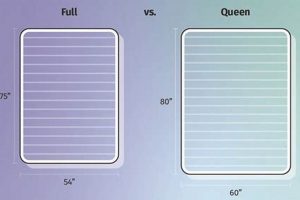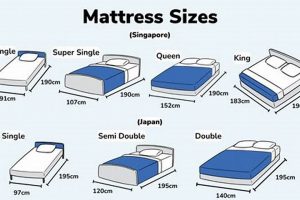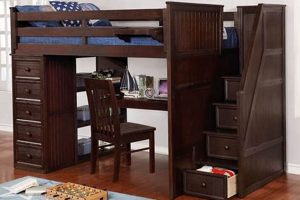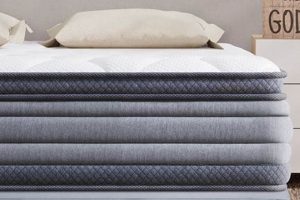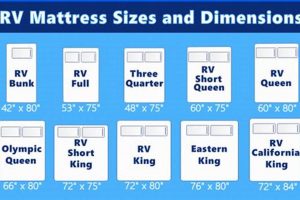A bedding surface designed to fit within the confines of a camper or recreational vehicle is frequently dimensioned to the size commonly described as “full.” This size typically measures approximately 54 inches wide by 75 inches long, offering sleeping space suitable for one or two individuals depending on body size and comfort preferences. The interior layout and available area within the camper often dictate the dimensions and shape of the bedding surface.
The selection of an appropriately sized sleeping surface is paramount for ensuring adequate rest and comfort during travel and camping excursions. A properly chosen model can significantly enhance the overall experience, mitigating discomfort and promoting restful sleep. Historically, these surfaces were often rudimentary, but contemporary options now incorporate advanced materials and construction techniques to optimize support and durability. Benefits include improved sleep quality, space optimization within the vehicle, and enhanced overall enjoyment of the camping experience.
The following discussion delves into various aspects relevant to choosing a suitable camper bedding option, encompassing material considerations, construction methods, size variations, and factors influencing overall comfort and longevity. These considerations are crucial for making an informed decision that aligns with individual needs and camping style.
Guidance on Camper Bedding Selection
Careful consideration of several factors is essential when selecting a sleeping surface for a camper. The following tips provide guidance to ensure optimal comfort, durability, and suitability for the intended use.
Tip 1: Measure the Available Space. Accurate measurements of the designated sleeping area within the camper are paramount. Ensure the chosen bedding conforms to the available dimensions without obstructing movement or access to other areas.
Tip 2: Consider Material Composition. Material selection influences comfort, temperature regulation, and durability. Options such as memory foam, latex, or innerspring offer varying levels of support and breathability. Evaluate the trade-offs based on individual preferences and climate conditions.
Tip 3: Evaluate Density and Support. Higher density foam generally provides greater support and longevity. Assess the firmness level to ensure adequate spinal alignment and pressure relief. Consider individual sleeping positions and body weight when determining the appropriate support level.
Tip 4: Assess the Need for Breathability. Adequate airflow is crucial to prevent overheating and moisture buildup. Materials with open-cell structures or integrated ventilation systems can enhance breathability, particularly in humid environments.
Tip 5: Factor in Portability and Storage. If storage space is limited, consider options that can be easily compressed or folded. Some designs feature integrated straps or carrying cases for convenient transport and storage.
Tip 6: Protect Against Moisture. Campers are often exposed to varying levels of humidity. A waterproof or water-resistant cover is essential to protect the sleeping surface from spills, condensation, and other forms of moisture damage.
Tip 7: Consider Bedding Weight. Weight can be a significant factor, particularly in smaller campers or trailers. Opt for lighter materials and construction methods to minimize the overall load on the vehicle.
Prioritizing accurate measurements, appropriate material selection, and adequate support will contribute to a more comfortable and enjoyable camping experience. Proper maintenance and protection will further extend the lifespan of the bedding surface.
The subsequent sections will explore specific types of camper bedding and address frequently asked questions related to their selection and care.
1. Dimensions and Fit
The “full camper mattress” is defined, in part, by its dimensions. Specifically, the correspondence between the mattress dimensions and the available space within the camper is a critical determinant of suitability. A mismatch in dimensions can lead to compromised functionality and diminished comfort. For instance, a mattress that is too long may obstruct doorways or interfere with slide-out mechanisms. Conversely, a mattress that is too short may leave unusable space or create uncomfortable gaps.
The importance of accurate fit extends beyond mere spatial compatibility. Proper dimensions ensure that the mattress is adequately supported by the bed frame or platform, preventing sagging or uneven weight distribution. Consider the example of a camper owner who purchased a purported “full camper mattress” online only to discover it was several inches narrower than advertised, resulting in inadequate support and a significantly reduced sleeping surface. Similarly, variations in mattress thickness can affect headroom and access to overhead storage compartments within the camper. The relationship between dimensions and fit is therefore a cause-and-effect relationship, where improper dimensions directly result in reduced comfort, functionality, and spatial efficiency within the camper.
In summary, precise adherence to dimensional specifications is paramount when selecting a “full camper mattress.” The practical significance of understanding this connection lies in the avoidance of potential fitment issues, the maximization of usable space, and the optimization of comfort and functionality within the confined environment of a camper. Ignoring these considerations often results in a compromised sleeping experience and necessitates costly alterations or replacements.
2. Material Composition
The constitution of a “full camper mattress” is fundamentally linked to its performance characteristics. The materials employed in its construction dictate factors such as support, durability, temperature regulation, and overall comfort. Selecting inappropriate materials can directly lead to issues such as inadequate support resulting in back pain, poor temperature regulation causing discomfort in varying climates, or premature degradation of the mattress, reducing its lifespan and necessitating frequent replacement. For example, a mattress composed primarily of low-density foam may offer an initial impression of softness, but will likely lack the necessary support for sustained use and will be prone to sagging over time. Conversely, a mattress constructed with high-density foam and a robust innerspring system is likely to provide superior support and longevity, albeit potentially at the expense of increased weight.
The choice of materials also has a significant impact on the mattress’s ability to resist moisture and odors, critical considerations in the typically enclosed and often humid environment of a camper. Mattresses incorporating moisture-wicking fabrics and antimicrobial treatments can help to mitigate the growth of mold and mildew, promoting a healthier sleeping environment. Furthermore, the material composition influences the mattress’s suitability for individuals with allergies or sensitivities. Hypoallergenic materials, such as latex or certain synthetic foams, can minimize the risk of allergic reactions and respiratory irritation. Consider the practical example of a camper owner with a dust mite allergy; selecting a mattress with a tightly woven, hypoallergenic cover and a non-organic fill material can significantly reduce exposure to allergens and improve sleep quality.
In summary, the material composition of a “full camper mattress” is not merely a superficial aspect but a critical determinant of its overall performance and suitability for the intended purpose. A thorough understanding of the properties and limitations of different materials is essential for making an informed purchasing decision. Failure to consider this connection can result in discomfort, reduced durability, and potential health concerns. The challenges of selecting appropriate materials are compounded by the diversity of options available, requiring careful evaluation and consideration of individual needs and preferences.
3. Support and Density
The terms support and density, when applied to a “full camper mattress,” denote distinct yet interdependent qualities influencing the overall sleeping experience. Support refers to the mattress’s ability to maintain proper spinal alignment and distribute body weight evenly, thereby reducing pressure points. Density, on the other hand, quantifies the mass of material per unit volume within the mattress core, a factor directly correlated with its durability and resistance to compression over time. A mattress lacking adequate support may contribute to musculoskeletal discomfort, while one with insufficient density is likely to exhibit premature sagging and a diminished lifespan. For example, a low-density foam mattress, despite its initial softness, will often compress significantly under body weight, leading to spinal misalignment and a compromised sleeping posture. This issue is exacerbated in campers, where space constraints may limit the ability to rotate or replace the mattress frequently.
The interplay between support and density is particularly crucial in the context of a “full camper mattress” due to the constraints imposed by camper design and usage patterns. Campers often experience fluctuations in temperature and humidity, conditions that can accelerate the degradation of low-density materials. Therefore, selecting a mattress with a higher density core material becomes essential for maintaining its structural integrity and providing consistent support over prolonged use. Furthermore, the limited space available in many campers often dictates the use of thinner mattresses. In such cases, maximizing both support and density within a reduced profile becomes a significant challenge. This can be achieved through the use of advanced materials such as high-density memory foam or hybrid designs incorporating both foam and innerspring elements.
In conclusion, the connection between support and density is a defining characteristic of a high-quality “full camper mattress.” Understanding this relationship empowers consumers to make informed purchasing decisions that prioritize comfort, durability, and long-term value. Neglecting either support or density considerations can lead to a compromised sleeping experience and necessitate premature replacement. The challenge lies in balancing these qualities within the practical limitations imposed by the camper environment. Prioritizing high-density materials and innovative support systems represents a strategic approach to optimizing the performance and longevity of a “full camper mattress.”
4. Portability/Storage
The aspects of portability and storage represent critical considerations when selecting a “full camper mattress,” particularly given the spatial constraints inherent in camper design. The ability to easily transport and stow the mattress, either for seasonal storage or during periods of camper use when the sleeping area must serve other functions, directly impacts the overall practicality and convenience of the sleeping solution.
- Compressibility and Foldability
Compressibility and foldability dictate the ease with which the mattress can be reduced in size for transport or storage. Mattresses constructed from materials such as memory foam or inflatable designs often exhibit superior compressibility compared to traditional innerspring models. This characteristic is particularly relevant for campers with limited storage capacity, as a highly compressible mattress can be readily stowed in smaller compartments or under seating areas. For instance, a “full camper mattress” designed to fold into thirds or quarters can significantly reduce its footprint during transport, freeing up valuable space within the vehicle.
- Weight Considerations
The weight of a “full camper mattress” directly influences its portability and the overall load on the camper. Lighter mattresses, typically constructed from foam or air-filled materials, are easier to maneuver and transport, minimizing the physical strain involved in setting up and breaking down the sleeping area. Conversely, heavier innerspring mattresses can pose a challenge, especially for individuals with limited physical strength or mobility. The weight consideration extends beyond ease of handling; a lighter mattress contributes to improved fuel efficiency for the camper and reduces the risk of exceeding weight restrictions imposed by vehicle manufacturers.
- Storage Dimensions and Shape
The packed dimensions and shape of a “full camper mattress” are crucial factors in determining its suitability for a particular camper. Irregularly shaped or bulky mattresses can be difficult to store efficiently, potentially requiring modifications to existing storage compartments or the creation of custom storage solutions. Mattresses that can be compressed into a compact, regular shape, such as a cylinder or rectangle, offer greater flexibility in terms of storage options. The ability to store the mattress in a standardized container or bag further enhances its portability and protects it from damage during transport and storage.
- Durability of Storage Materials
The materials used in the construction of storage bags or covers for a “full camper mattress” are critical for ensuring its long-term protection and portability. Durable, water-resistant fabrics, reinforced seams, and secure closures are essential for shielding the mattress from moisture, dust, and physical damage during storage and transport. Inadequate storage materials can lead to premature degradation of the mattress, potentially requiring costly repairs or replacements. The storage cover should also be designed to facilitate easy handling and carrying, with features such as reinforced handles and straps.
These considerations underscore the integral relationship between portability, storage, and the overall suitability of a “full camper mattress.” Choosing a mattress that effectively addresses these factors enhances the user experience, optimizes space utilization within the camper, and prolongs the lifespan of the sleeping solution. Prioritizing these features directly contributes to the convenience and practicality of the camper, ultimately improving the overall travel experience.
5. Moisture Resistance
Moisture resistance is a critical characteristic for any “full camper mattress,” directly impacting its longevity, hygiene, and the overall comfort of the sleeping environment within the enclosed space of a camper. The inherent limitations of camper ventilation and the potential for condensation necessitate a mattress design that effectively mitigates the absorption and retention of moisture.
- Material Permeability
The inherent permeability of the materials used in the construction of a “full camper mattress” dictates its susceptibility to moisture absorption. Materials such as open-cell foam, while offering breathability, are inherently more porous and prone to retaining moisture than closed-cell alternatives. Consequently, prolonged exposure to humidity or spills can lead to the growth of mold and mildew within the mattress core, resulting in unpleasant odors, potential health hazards, and accelerated degradation of the materials. For instance, a “full camper mattress” composed primarily of untreated cotton batting will readily absorb moisture from the surrounding environment, creating a breeding ground for microbial growth. The selection of materials with low permeability is therefore a paramount consideration.
- Waterproof Barriers and Covers
The incorporation of waterproof barriers or covers represents a proactive approach to enhancing the moisture resistance of a “full camper mattress.” These barriers, typically constructed from materials such as polyurethane or vinyl, create a protective layer that prevents liquids from penetrating the mattress core. However, the effectiveness of these barriers hinges on their integrity and breathability. A poorly constructed or non-breathable barrier can trap moisture within the mattress, creating a humid environment that promotes microbial growth. The practical implication is that a “full camper mattress” equipped with a waterproof cover should also feature ventilation mechanisms, such as breathable side panels or a moisture-wicking fabric lining, to facilitate airflow and prevent moisture buildup. This balanced approach ensures protection against spills while mitigating the risks associated with trapped moisture.
- Ventilation and Airflow
Adequate ventilation and airflow are essential for managing moisture within a “full camper mattress.” Ventilation channels or breathable materials promote the evaporation of moisture, preventing it from accumulating within the mattress core. The design of the camper itself also plays a role in this regard; ensuring adequate ventilation within the camper interior helps to reduce the overall humidity level and minimize the risk of moisture condensation on the mattress surface. For example, the use of desiccant packs within the camper, coupled with regular airing out of the mattress, can significantly reduce the amount of moisture retained within the mattress over time. The combination of proper mattress design and effective camper ventilation is crucial for maintaining a dry and hygienic sleeping environment.
- Resistance to Microbial Growth
The inherent resistance of the mattress materials to microbial growth is a critical factor in determining its long-term performance and hygiene. Materials treated with antimicrobial agents inhibit the growth of bacteria, mold, and mildew, reducing the risk of unpleasant odors, allergies, and potential health problems. However, the effectiveness of these treatments can vary depending on the type of antimicrobial agent used and the duration of its efficacy. Furthermore, some individuals may be sensitive to certain antimicrobial chemicals, necessitating careful consideration of the material composition. The practical implication is that a “full camper mattress” marketed as antimicrobial should be accompanied by transparent information regarding the type of treatment used and its potential impact on sensitive individuals. Regular cleaning and maintenance of the mattress, regardless of its antimicrobial properties, are essential for maintaining a hygienic sleeping environment.
These facets underscore the intricate relationship between moisture resistance and the overall performance and longevity of a “full camper mattress.” The selection of appropriate materials, the incorporation of waterproof barriers and ventilation mechanisms, and the use of antimicrobial treatments are all essential strategies for mitigating the risks associated with moisture exposure. Ignoring these considerations can lead to a compromised sleeping environment, reduced mattress lifespan, and potential health hazards. A holistic approach to moisture management, encompassing both mattress design and camper ventilation, is paramount for ensuring a comfortable and hygienic sleeping experience.
Frequently Asked Questions
This section addresses common inquiries concerning the selection, use, and maintenance of a full camper mattress. The information provided aims to clarify misconceptions and offer practical guidance for optimal product performance.
Question 1: Is a standard full mattress suitable for use in a camper?
While a standard full mattress shares similar dimensions with a full camper mattress, variations in thickness and construction may render it unsuitable. Campers often have limited vertical space, and a thicker standard mattress may impede movement or storage. Furthermore, standard mattresses may lack the durability and moisture resistance required for the fluctuating environmental conditions within a camper.
Question 2: What materials are best suited for a full camper mattress in humid climates?
In humid climates, materials with moisture-wicking properties and resistance to mold and mildew are essential. Closed-cell foam, latex, and mattresses with waterproof or water-resistant covers are preferable. Regular ventilation and the use of dehumidifying agents within the camper can further mitigate moisture accumulation.
Question 3: How can the lifespan of a full camper mattress be extended?
The lifespan can be extended through several measures. Regular cleaning, the use of a mattress protector, and periodic rotation or flipping (if applicable to the mattress type) can prevent uneven wear and the accumulation of dirt and moisture. Proper storage during periods of non-use, in a dry and well-ventilated environment, is also crucial.
Question 4: What is the recommended density for a full camper mattress designed for two adults?
For two adults, a higher density foam is generally recommended to provide adequate support and prevent sagging. A density of at least 2.5 pounds per cubic foot is advisable for memory foam mattresses, while latex mattresses should have a density of at least 4 pounds per cubic foot. Innerspring mattresses should have a coil count appropriate for the weight and size of the occupants.
Question 5: Can a full camper mattress be customized to fit a non-standard camper bed frame?
Customization is possible, but may require professional services. Many mattress manufacturers offer custom sizing options, allowing for adjustments in length, width, and thickness to accommodate unique bed frame dimensions. Alternatively, a standard mattress can be modified by a qualified upholstery professional, although this may void any existing warranty.
Question 6: Are there specific cleaning products that should be avoided when maintaining a full camper mattress?
Harsh chemicals, abrasive cleaners, and excessive amounts of water should be avoided, as these can damage the mattress materials and promote moisture buildup. Instead, mild detergents, specialized mattress cleaning solutions, and gentle blotting techniques are recommended. Always consult the manufacturer’s care instructions for specific guidance.
The selection and maintenance of a full camper mattress require careful consideration of factors such as material composition, climate conditions, and usage patterns. Adhering to the recommendations outlined above can enhance the comfort, durability, and longevity of the product.
The following section will explore various types of camper bedding accessories that can further enhance the sleeping experience.
Full Camper Mattress
This discussion has elucidated the multifaceted considerations surrounding the selection, utilization, and maintenance of a full camper mattress. Key aspects explored included dimensional compatibility, material properties, support mechanisms, portability constraints, and moisture management strategies. Understanding these elements is essential for optimizing comfort, durability, and hygiene within the confined environment of a recreational vehicle.
The informed selection of a full camper mattress represents a significant investment in travel comfort and well-being. Prudent application of the principles outlined herein will contribute to a more restful and enjoyable camping experience. Continued advancements in materials and manufacturing processes suggest a future trajectory characterized by enhanced performance, durability, and customization options, further solidifying the integral role of the full camper mattress in the mobile living landscape.


![Best Full Size Orthopedic Mattress [Guide] For Back Pain Organic & Natural Mattress Buyer’s Guide: Non-Toxic Sleep Solutions Best Full Size Orthopedic Mattress [Guide] For Back Pain | Organic & Natural Mattress Buyer’s Guide: Non-Toxic Sleep Solutions](https://mattressworldpa.com/wp-content/uploads/2025/07/th-2835-300x200.jpg)
